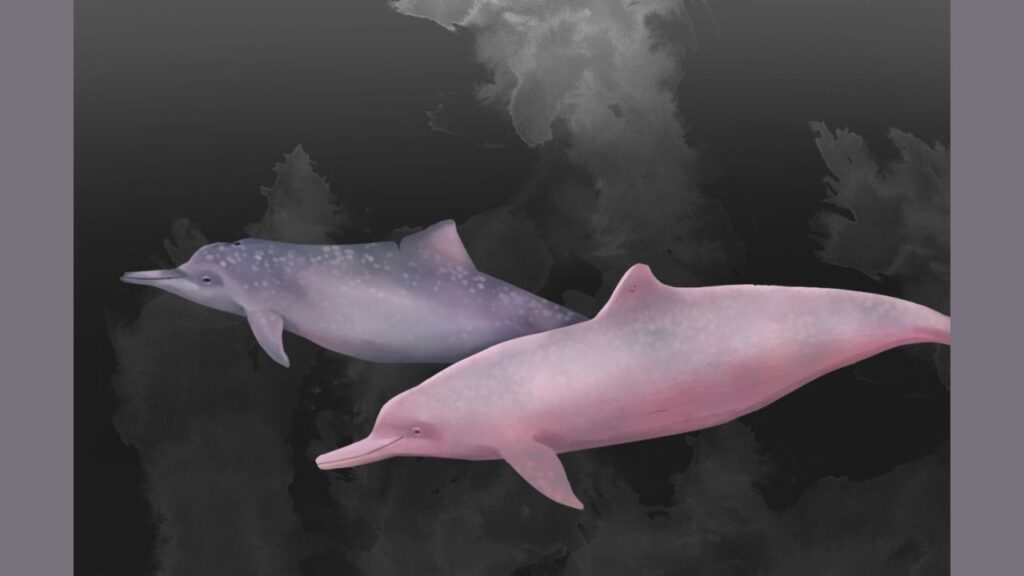
Are you looking for an explanation about the captivating pink hue of the Chinese Pink Dolphin, a mesmerizing creature found in the vast waters of the Pearl River Delta and the South China Sea?
These dolphins, with their unique pink coloration, stand out against the ocean backdrop, prompting curiosity about the reason behind their distinctive hue.
Why Are Chinese Pink Dolphins Pink? Chinese pink dolphins gain their pink hue from blood vessels that are close to the skin, and the layer of fat beneath it.
Table of Contents
- 1 The Fascinating Hue of Chinese Pink Dolphins
- 2 Genetics at Play: Melanin and Albino Traits
- 3 Environmental Factors: Diet and Habitat
- 4 Cultural Significance: Mythology and Symbolism
- 5 Conservation Efforts: Protecting the Pink Dolphins
- 6 Frequently Asked Questions (FAQs)
- 7 Conclusion: Why Are Chinese Pink Dolphins Pink?
The Fascinating Hue of Chinese Pink Dolphins
The enchanting pink hue of Chinese Pink Dolphins, scientifically referred to as Sousa chinensis, distinguishes them as one of the most captivating marine species in the world.
Their unique coloration, ranging from delicate shades of pale pink to vibrant hues reminiscent of a sunset’s blush reflected on the water’s surface, sets them apart from their dolphin counterparts.
This distinctive trait has prompted numerous scientific inquiries and theories aimed at unraveling the mystery behind their pink hue.
Genetics at Play: Melanin and Albino Traits
One prominent theory delves into the genetic underpinnings behind the pink coloration of Chinese Pink Dolphins.
Like all dolphins, these marine mammals possess melanin, a pigment crucial for the coloration of their skin.
But when it comes to Chinese Pink Dolphins, a particular set of genes controls the production of a paler coloring, giving them their striking pink hue.
Individuals within the species exhibit varied levels of pink pigmentation, which is a result of this genetic variety. [Why Are Chinese Pink Dolphins Pink?]
Moreover, albinos, who lack melanin in their skin, eyes, and hair, may manifest in certain Chinese Pink Dolphins. In many cases, their lack of melanin intensifies the pink color, making for an enthralling sight as they glide through the blue waters of their home.
The existence of albino individuals amidst Chinese Pink Dolphins highlights the intricacy of hereditary elements impacting their coloring and contributes an additional level of mystery to their already appealing charm.
See Also: Where Are Pink Dolphins Found? Unraveling the Mystery

Environmental Factors: Diet and Habitat
Habitat Preference: Chinese Pink Dolphins predominantly inhabit estuarine and coastal waters, where they find an abundance of food sources and suitable environmental conditions for their survival.
Diverse Diet: These dolphins have a varied diet consisting of fish, crustaceans, and cephalopods. Their consumption of a wide range of prey species provides them with essential nutrients and compounds that may influence their skin pigmentation.
Krill and Shrimp Consumption: Certain components present in their diet, such as krill and shrimp, are rich in pigments or carotenoids. These substances have the potential to contribute to the pink pigmentation of their skin when consumed regularly over time.
Pigment Accumulation: Chinese Pink Dolphins may build pigments in their bodies as a result of regularly consuming krill and shrimp, which will eventually cause their skin to turn pink.
Sunlight Exposure: The particular environmental factors of their habitat, such as the amount of sunlight they receive, might also have an impact on how their pink coloring develops. Sunlight can react with the pigments in their skin, changing or enhancing their color over time.
Water Quality: Another environmental aspect that may have an impact on how their pink coloring develops is the quality of the water in their habitat. Their skin pigmentation may be negatively impacted by pollution and toxins in the water, underscoring the significance of maintaining clean and healthy aquatic habitats.
Interplay of Environmental Factors: The intricate process of determining the pink hue of Chinese Pink Dolphins is probably influenced by the interplay between a number of environmental factors, including diet composition, sunshine exposure, and water quality.
Research Needed Further: Although there are theories on how their habitat and food affect their pink pigmentation, more study is required to pinpoint the exact interactions and mechanisms causing this phenomenon.
Further research will improve our comprehension of the environmental influences forming the fascinating coloring of these amazing aquatic animals.
Cultural Significance: Mythology and Symbolism
Chinese pink dolphins are extremely important to coastal communities’ culture and mythology, even outside the domain of science.
These dolphins are considered supernatural creatures connected to protection, prosperity, and good fortune in Chinese culture. [Why Are Chinese Pink Dolphins Pink?]
Chinese Pink Dolphin sightings are said to portend good fortune and blessings from the water, according to old legends.
Living along the seaside, people have a great deal of respect for these magnificent animals because of their pink color, which represents purity, harmony, and the connection between humans and the natural world.
See Also: Are Pink Dolphins Real? Unveiling the Mystery

Conservation Efforts: Protecting the Pink Dolphins
Chinese Pink Dolphins are endangered in the contemporary world despite their great reputation in legend.
Overfishing, pollution, and coastal development are just a few examples of how human activity has greatly affected their population and environment.
A comprehensive conservation effort is underway to protect Chinese Pink Dolphins for future generations, with an emphasis on habitat preservation, sustainable fishing methods, and public awareness initiatives.
We can make sure that future generations continue to be awestruck by the captivating beauty of these recognizable marine mammals by supporting responsible stewardship of coastal habitats and increasing awareness of the significance of marine conservation.
Frequently Asked Questions (FAQs)
Why Are Chinese Pink Dolphins Pink?
Chinese Pink Dolphins gain their pink hue from genetics and diet, specifically from pigments in krill and shrimp. [Why Are Chinese Pink Dolphins Pink?]
Are Chinese Pink Dolphins Albino?
While some may show albino traits, not all Chinese Pink Dolphins are albino, with varying levels of pink pigmentation.
Where Are Chinese Pink Dolphins Found?
Chinese Pink Dolphins inhabit coastal waters, especially in the Pearl River Delta and South China Sea.
Are Chinese Pink Dolphins Endangered?
Yes, they’re vulnerable due to threats like habitat loss and pollution.
What’s The Significance Of Their Pink Color?
The pink color symbolizes purity and adds to their allure as iconic marine mammals.
Conclusion: Why Are Chinese Pink Dolphins Pink?
Hopefully, you now understand that the mysterious pink color of Chinese Pink Dolphins is a fascinating combination of environment, genetics, and cultural symbolism.
One thing is certain as you explore the mysteries of their distinctive coloring: these elegant animals represent the ocean and serve as reminders of the precarious equilibrium that exists between nature and humanity.
Let us appreciate the beauty of nature’s color palette and the beauty of Chinese Pink Dolphins as I work to protect and preserve their habitat.

Mr. Das, a certified pharmaceutical scientist, holds a Bachelor of Science in Pharmaceutical Sciences and passionately contributes to dolphin conservation as a member of the committee in Bangladesh.


